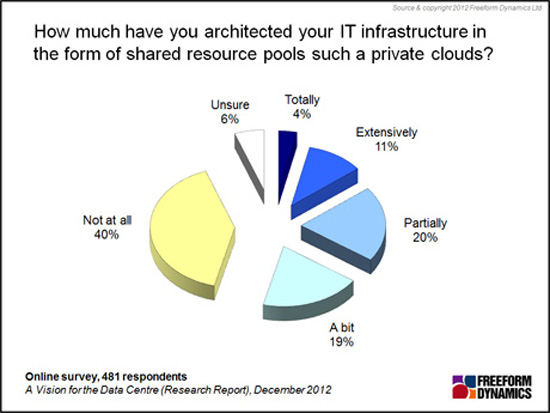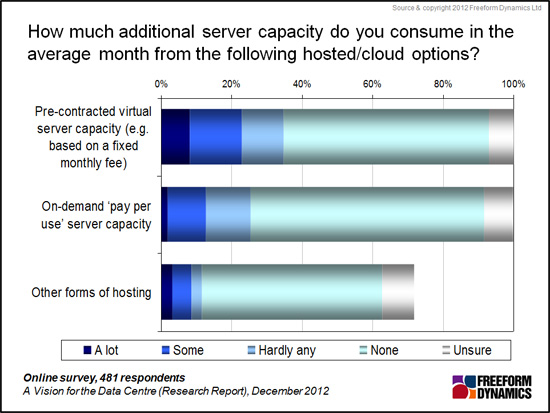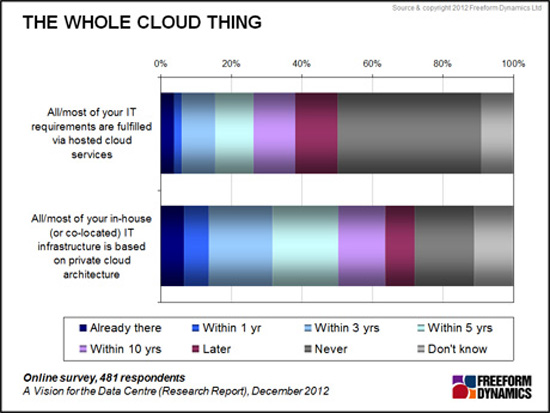By Tony Lock
Enterprise Data Centres are complex collections of systems acquired over long spans of time, after being assembled piece by piece. Thus Data Centres change slowly over time, making it difficult to manage their evolution as new systems are deployed and old ones fade away slowly, if at all. Recently some vendors and commentators have started to ask – “are data centres, as they exist today, going to be relevant tomorrow when, at least according to some, all IT services will be delivered from ‘The Cloud’?”
Where are we today, in terms of Cloud adoption? Have any of the main Cloud bandwagons, Private, Public and Hybrid really started rolling? These are questions which Freeform Dynamics continues to research – with answers that are pretty consistent.

Figure 1
For example, in a Freeform Dynamics web survey we asked IT professionals (working in enterprises large and small) how they felt data centres would change in the future. Before analysing the data, we sought to establish where such users are positioned currently – especially in terms of Cloud adoption.
As can be seen from Figure 1, few organisations reported that they had already built their IT infrastructure on ‘Private Cloud’ type models – where the IT infrastructure is owned and managed internally by the enterprise.
Despite the relatively low level of adoption of Private Clouds (and this from a survey base likely to be more advanced in its thinking as Web surveys nearly always attract early adopters in disproportionate measure), the attributes associated with Private Clouds seem to be well understood. For example, the survey indicated that the essentials of a Cloud architecture are attractive to many organisations. Thus the use of Private Cloud-style architectures to deliver IT services is likely to increase steadily in the near future. If it is clear that Private Cloud usage is attractive and its usage is slowly taking off, what about ‘Public’ Cloud adoption today?

Figure 2
Figure 2 shows that some mainstream enterprises already make at least selective use of Public Cloud resources. That said, the use of Public Cloud has yet to take off with the rapidity forecast by some evangelists, IT vendors and service providers.
Indeed, our research over recent years is consistent in indicating that the majority of enterprises view the use of Public Cloud in a tactical context rather than as a strategic way forwards. In essence Public Cloud is deemed to be suitable for host certain business services, for example hosting of test systems or running less sensitive business applications that have little integration with other enterprise applications and data. It is not thought appropriate, yet, for hosting others, notably those with demands of high security or where there may be regulatory / governance restrictions preventing them running outside of the organisation’s own resources.
Figure 2 also shows the utilisation of Public Cloud resources based on ‘pay per use’ models to be low. The indications are that the adoption of Public and Hybrid Cloud usage (the latter being where organisations use their own resources and those of external suppliers in tandem) have considerable challenges to address if either model is to alter the data centre landscape quickly. In particular this result indicates that using Public Cloud resources in “burst mode” to supplement Internal Cloud, an area for which many vendors and Service Providers have great expectations, is yet to garner significant traction.

Figure 3
To put this into perspective, when we asked how long respondents thought it would be before either Private or Public Clouds became a major component in the way that IT will deliver data centre services, the answers varied considerably (Figure 3). Even large scale adoption of Private Clouds was thought by nearly 50% of respondents to be at least five years away; this is despite widespread acknowledgement that the operational service delivery benefits inherent in the model are well understood.
When it comes to utilising Public Cloud to deliver most requirements, expectations are markedly less enthusiastic. Fewer than a third of enterprises expect to satisfy the majority of their IT requirements via the Public Cloud model within a decade. More striking still, around half believe this approach will never be employed by their organisations. More significantly, there is no evidence from this survey (or others we have undertaken) to indicate attitudes to Public Cloud will change materially in the short to medium term.
Instead, the main issue to be considered is how those IT services which users rely on will change in the coming years as they provide effective and secure services. It is this that will shape how data centres will evolve. These factors will then shape how data centre Cloud adoption – whether Public, Private or Hybrid – will play going forwards.
Other results revealed by the research indicate that whatever the destination, very few organisations plan to undertake big data centre transformation projects to modernise things across the board. Instead the approach most likely to be taken will be to build a modern environment for new systems to which existing systems can migrate over time. Some of these data centre updates will have the effect of introducing some Cloud-like functionality into data centres. If true this means that Private Cloud adoption will occur less as the consequence of a single project and more from successive iterations of solutions whose functional capabilities build on top of each other.
To conclude: Data centres change slowly – at a pace dictated by a combination of changing business service requirements and how quickly new technology solutions become available, affordable and “trusted”. To date there is little sign that the adoption of any type of the Cloud architecture model will occur in a hurry. Rather adoption will happen when and where the capabilities available from any of the Cloud models suit specific business requirements. Sadly for Cloud vendors and evangelists, common sense will reign: Cloud adoption will happen as determined by IT and the business, and not through vendor marketing budgets or ongoing hype.
